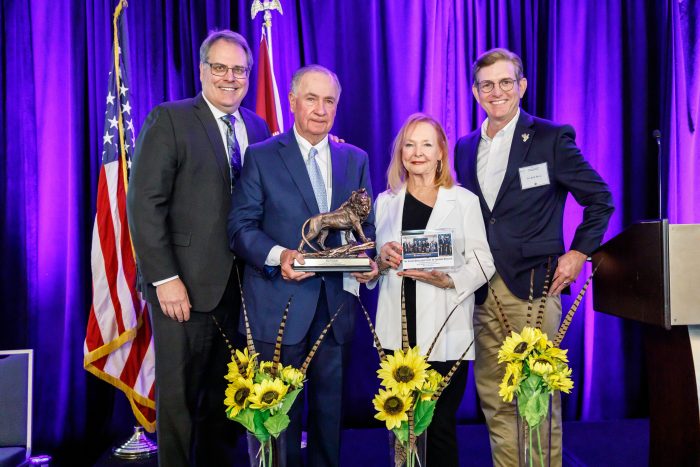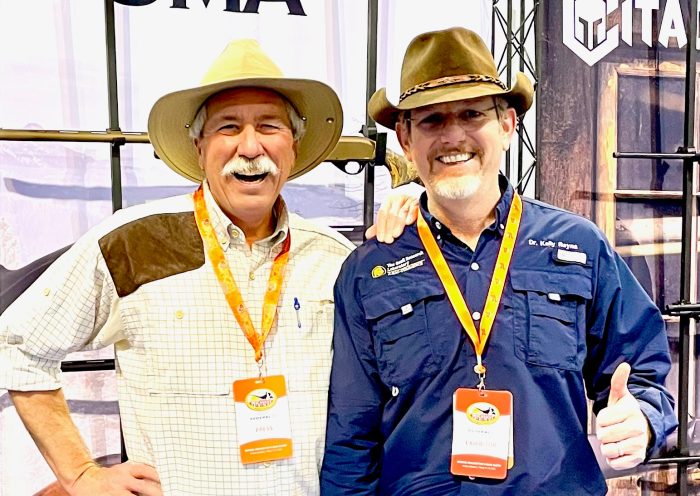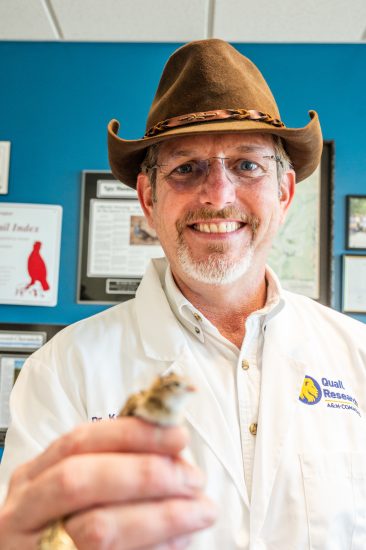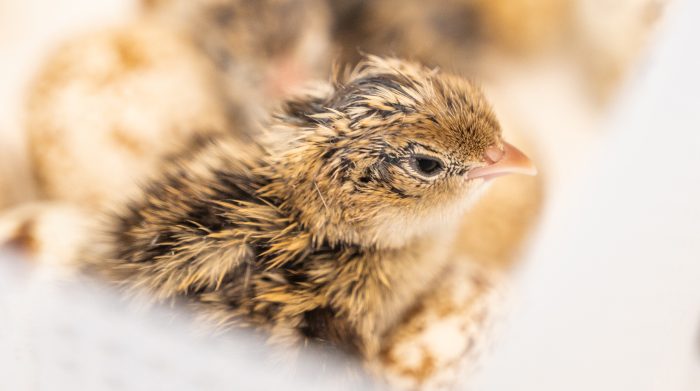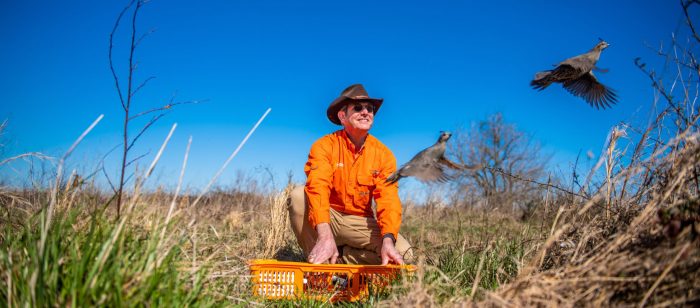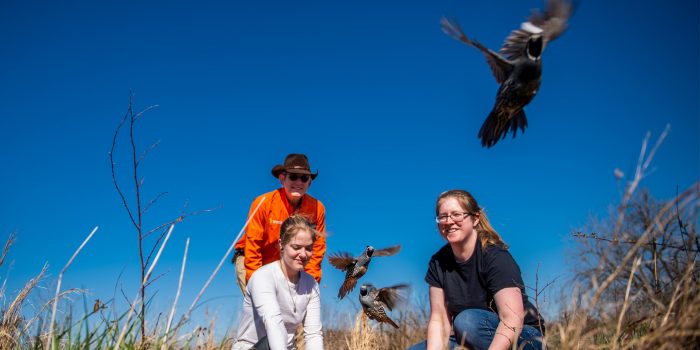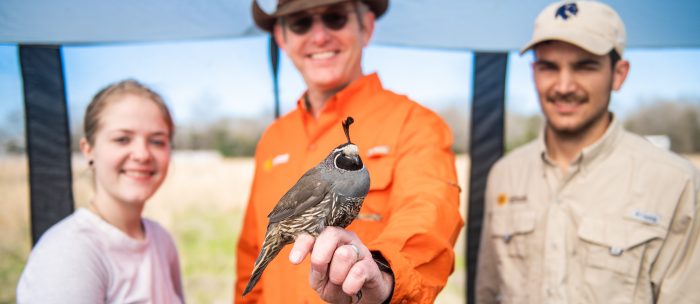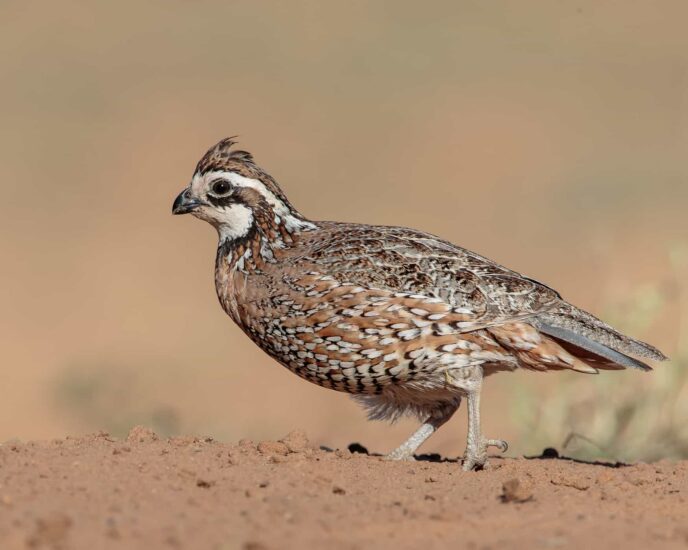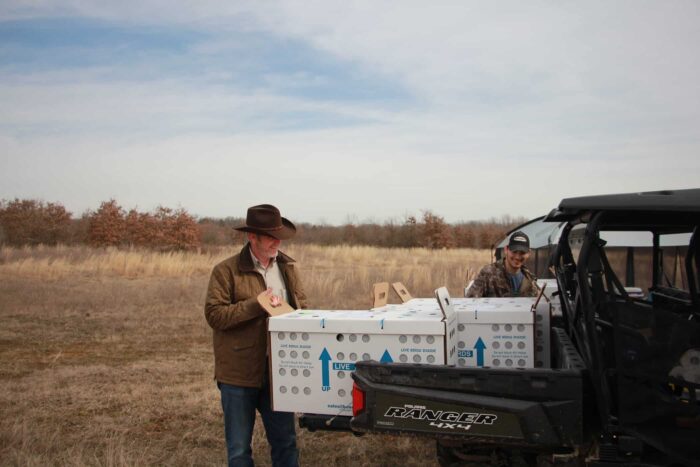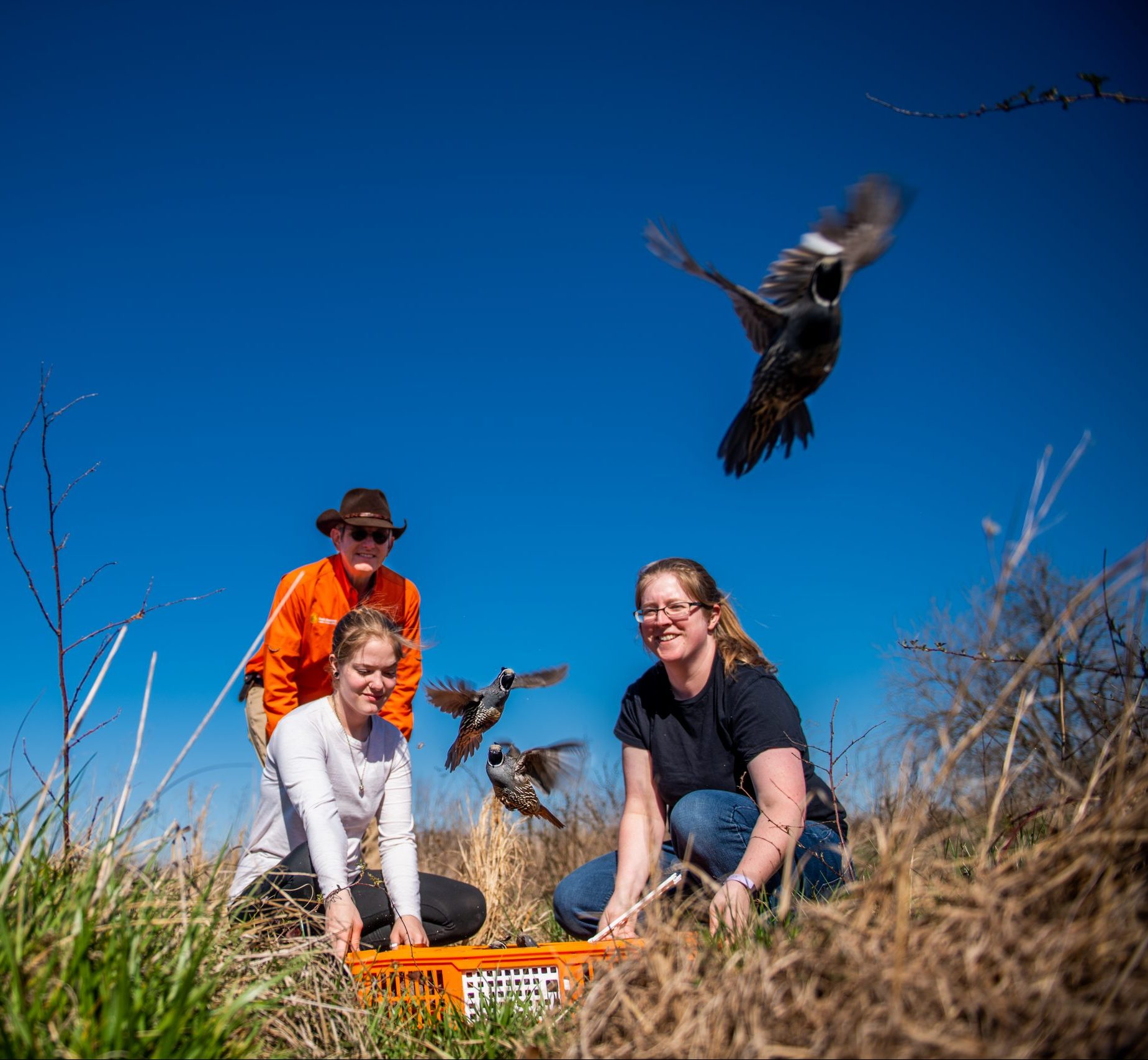
- On this page:
-
 Featured Publications
Featured Publications
-
 Featured News Quail
Featured News Quail
Human Dimensions Of Quail Sustainability
With declining populations of quail where there once was a thriving population, it is important to step back and consider how humans contribute to this change.
Abstract
One of the biggest wildlife conservation challenges of our time is the declining numbers of quail, quail hunters, and quail conservationists. U.S. quail species are some of the most important socioeconomic birds of our lifetime, and their downward trend threatens the $2.2 billion annual upland hunting industry. The human dimensions of quail sustainability consider the role that humans play in every stage of the socio-economic system, including, communications, decision-making, economics, ethics, governance, management, science, social systems, stakeholders, and values. For example, each year, millions of acres of quail habitat are lost to agriculture and human development, and many quail leases are lost to overgrazing. Because much of quail habitat is privately owned, the onus is often on the landowner to be the primary quail conservationist. The Quail Research Laboratory is investigating the human dimensions of quail conservation and fostering solutions for quail population sustainability.
Featured Publications
Funds generated and spent on the pursuit of quail (Colinus virginianus, Callipepla squamata) hunting in Texas are sizable. We surveyed a population of quail hunters in Texas in 2000 and 2011 to assess hunter demographics and spending habits. The population of hunters for the 2000 survey consisted of members of Quail Unlimited who lived in Texas while the 2011 population consisted of the former group's successor in Texas—Quail Coalition. The initial (2000) survey was a mail questionnaire while the 2011 survey instrument was delivered electronically.
We achieved response rates of 47% in 2000 but only 9% in 2011. The number of resident quail hunters in Texas decreased by 72% from 1981 to 2010. Quail hunters in Texas can be characterized as white males (97%) and affluent (65% reported annual household incomes above $125,000 in 2010).
Survey respondents documented an average expenditure of $8,606 in pursuit of quail during an average of 8.8 days of hunting during the 2010–2011 season. This resulted in a cost of $254 per quail bagged when combined with harvest estimates provided by respondents; an estimated increase of 23% over the last 10 years.
The Texas Quail Index (TQI) was a 5-year, science-based project that utilized citizen scientists to collect data in the field, including 5 indices of bobwhite abundance in the spring, and 3 indices of bobwhite abundance in the fall. Over the course of the study, 84% of all volunteers dropped out of the program and, 8% of all data sets were complete.
Accordingly, we surveyed the volunteers by mail to determine the rate and cause of participation decline and to identify the characteristics of a reliable volunteer. Results indicated that the annual volunteer participation rate declined more rapidly as time and labor requirements increased. Similarly, 74.3% of survey respondents who dropped out of the study reported leaving because the project required too much time and work. Motives may have contributed to
the volunteer attrition as 72% of volunteers joined the program to learn more about quail management; however, 71% of those that left the program reported not gaining knowledge in that area.
We recommend that project designs, for citizen-science projects, should incorporate the motives of volunteers and recruit those whose motives best align with project goals. We also recommend that citizen science coordinators keep volunteer tasks short and within the interest of the volunteer, to increase retention. Finally, we recommend stipends for volunteers on large-scale, laborious projects.
The northern bobwhite (Colinus virginianus; hereafter, bobwhite) population decline has prompted several studies over the past decade investigating bobwhite population genetics and overall connectivity. The zeitgeist of current quail conservation is that bobwhite populations have become increasingly fragmented, leading to their decline as a result of reduced fitness associated with the effects of small population size. A few studies exploring population-level patterns of genetic connectivity at the local scale have identified some areas possessing limited gene flow likely due to recent anthropogenic landscape changes. Interestingly, however, multiple studies using genetic methods have also suggested that the species has experienced a recent range-wide expansion with few barriers to dispersal, suggesting a large panmictic population.
Although the above are both supported by empirical data, we highlight another possibility that has been proposed yet rarely investigated. Millions of wild bobwhites have been transported among populations, and millions more captive-reared bobwhites have been and continue to be released across the species' range. Given the massive scale at which bobwhites have been artificially dispersed, more research is needed to investigate the effects of introgression of nonlocal birds on our ability to understand recent changes in bobwhite population fragmentation, size, and diversity. Such information has important management implications for long-term bobwhite population sustainability.
By quantifying the level of human-mediated bobwhite dispersal events, our review cautions against assigning evolutionary or conservation significance to patterns of genetic connectivity among bobwhite populations until a more systematic effort is made to verify that such activities have not affected our ability to identify natural gene-flow patterns at both local and broad-scale distributions. © 2017 The Wildlife Society.
Humans have employed chemical methods of pest control since the earliest days of agriculture and these substances have affected native wildlife, including quail and other gamebirds (Galliformes), to varying degrees. Several quail species have experienced steep population declines over the past several decades and insecticides may be a contributing factor.
Quail are also known to use agricultural habitat for nesting and foraging purposes and are therefore likely to encounter elevated levels of insecticidal chemicals in the soil, vegetation, and insect biomass in that environment. The first commercially available insecticides appeared in the early 1900s with the introduction of arsenic-based compounds (arsenicals). Chemical engineering during World War II resulted in arsenic being replaced with synthetically produced insecticides such as organochlorine, carbamate, and organophosphate compounds over several decades.
Many of these substances have been shown to increase mortality rate, alter behavior, and produce severe reproductive complications in quail, both in the lab and the field. Today, the world's most popular insecticides, neonicotinoids, are being reevaluated for environmental safety following reports that they may be affecting nontarget wildlife. This review examines the types of insecticides that have been used in the United States, how quail could be exposed to these substances, and how they may have contributed to declining quail populations.
Martin, J.A., R.D. Applegate, T.V. Dailey, M. Downey, B. Emmerich, F. Hernandez, M.M. McConnell, K.S. Reyna, D. Rollins, and T. M. Terhune. 2017. The State of Our Knowledge: Translocation, Reintroduction, and Rearing Northern Bobwhites for Restoration. National Quail Symposium Proceedings 8: 1–16.
Northern bobwhite populations are dwindling across their range. Accordingly, in areas with bobwhite habitat restoration and no nearby populations, effective population restoration techniques are needed. Here, we evaluated three bobwhite restoration release strategies: (1) release of captive-reared bobwhites on sites with and without resident populations, (2) translocation of wild-trapped bobwhites from a region of high population density to a region with no population, and (3) release of captive-reared and wild-translocated bobwhites acclimated on site prior to release in year 2.
Wild-translocated birds survived longer than captive-reared birds. Mean survival for captive-reared bobwhites was 2.42 weeks and 4.27 weeks in year 1, and 1.91 and 1.40 weeks in year 2, for study sites without resident and with resident birds present, respectively. Mean survival for wild-translocated birds was 8.50 weeks in year 1 and 11.54 weeks in year 2. Wild-translocated birds dispersed shorter distances than captive-reared birds. Both captive-reared and wild-translocated bobwhites were only nested on study sites with conspecifics. Captive-reared birds had 0 nesting attempts on the site with no resident bobwhites and ⩾8 nests on the site with resident bobwhites. Wild-translocated females nested six times and were subsequently observed with juveniles. On-site acclimation did not increase post-release survival for northern bobwhites. Acclimation increased site fidelity but reduced survival for captive-reared birds and had no impact on survival for wild-translocated bobwhites.
Population restoration by release of captive-reared or wild-translocated birds is not irrelevant, but further investigation is needed into the relationship between captive-reared birds and predators, and methods to increase survival and reproduction of released birds.
Gomez, L.J., and K.S. Reyna. 2017. An Evaluation of Northern Bobwhite Conservation Research: A Call for Large-scale Studies. National Quail Symposium Proceedings 8: 119–131.
How have thriving elk populations of thousands dwindled to mere hundreds in just a matter of years? Author Ted B. Lyon asserts the wolf is at fault. He also blames the wolf for the rampant spread of infectious diseases among livestock populations and the decimation of wild deer, moose, sheep, and domestic animals alike. A trial lawyer with over 37 years of litigation experience, Lyon proves his case in The Real Wolf: The Science, Politics, and Economics of Co-Existing with Wolves in Modern Times.
In this detailed yet easy-to-read essay collection, authors Ted B. Lyon and Will N. Graves investigate the majesty and myths surrounding wolves in the United States and offer a new, true picture of the wolf in contemporary America. The Real Wolf is an in-depth study of the impact wolves as a federally protected species have had on big game and livestock populations.
Each chapter in the book is meticulously researched and written by authors and scientists who have spent years studying wolves and wolf behavior. Contributing authors Rob Arnaud, Dr. Arthur Bergerud, Karen Budd-Falen, Jess Carey, Dr. Matthew A. Cronin, Dr. Valerius Geist, Don Peay, Laura Schneberger, Heather Smith-Thomas, and Cat Urbigkit each describe a unique aspect of the wolf in the United States. The Real Wolf does not call for the eradication of wolves from the United States but rather advocates a new system of species management that would allow wolves, game animals, and farmers to live in harmony.
The annual abundance of northern bobwhites (Colinus virginianus) fluctuates drastically in semi-arid environments (e.g., Texas), which complicates the ability of wildlife biologists and quail managers to predict annual bobwhite productivity and relative abundance for the ensuing hunting season. The Texas Quail Index (TQI) was a 5-year citizen science project that evaluated several indices as predictors of bobwhite productivity and abundance during the subsequent fall. Indices included spring cock-call counts, forb species richness, simulated nest fate, potential nest-site density, scent station visitation rates, roadside counts, fall covey call counts, and harvest data.
Spring cock-call counts explained only 41% of the variation in fall bobwhite abundance across all study sites in years 1–4; yet explained 89% of the variation in year 5. The percentage of juveniles in the fall population (an index of bobwhite productivity) was significantly lower in year 5. All study sites experienced drought conditions throughout year 5 based on the Palmer Drought Severity Index (PDSI). Thus, drought conditions in semi-arid environments result in reduced productivity compared to non-drought years.
Our results suggest low recruitment during drought years makes fall bobwhite abundance more predictable than during non-drought years. Wildlife biologists and quail managers should have a better ability to predict bobwhite productivity and fall abundance in drought years by recording spring cock-call counts.



